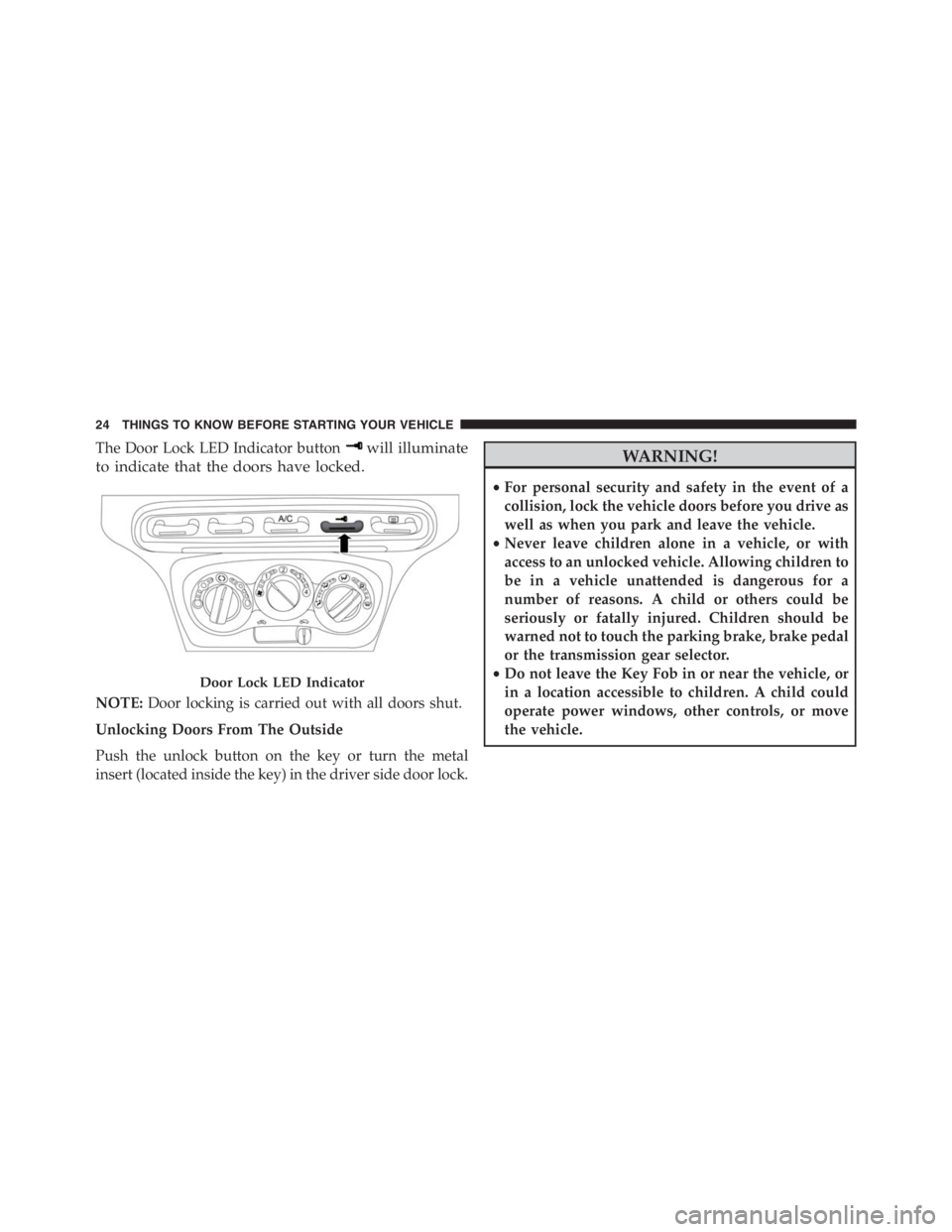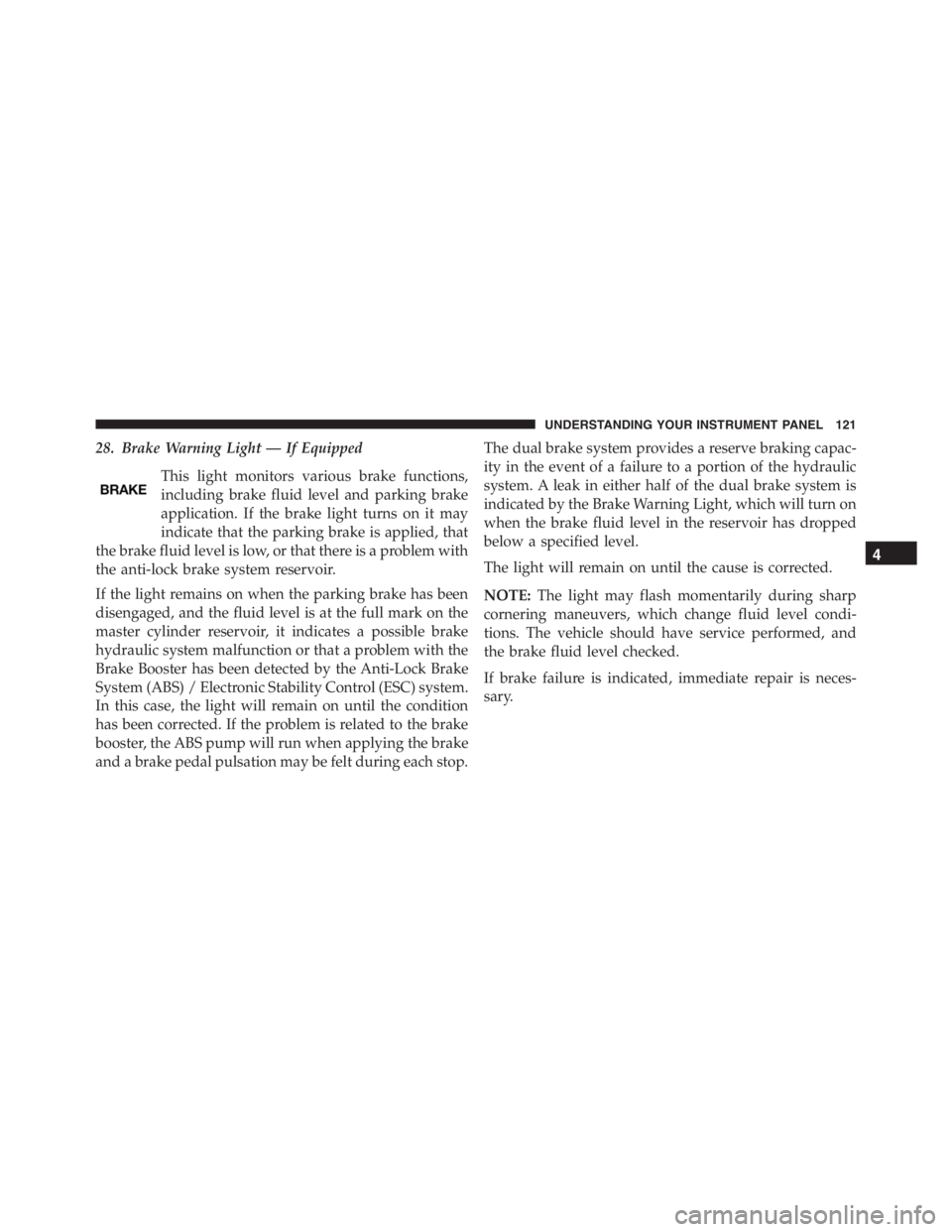Page 14 of 348
3. Remove the key from the ignition switch lock cylinder.WARNING!
•Before exiting the vehicle, always apply the park-
ing brake, and remove the Key Fob from the
ignition. When leaving the vehicle, always lock
your vehicle.
•Never leave children alone in a vehicle, or with
access to an unlocked vehicle.
•Allowing children to be in a vehicle unattended is
dangerous for a number of reasons. A child or
others could be seriously or fatally injured. Chil-
dren should be warned not to touch the parking
brake, brake pedal or the transmission gear selec-
tor.
•Do not leave the Key Fob in or near the vehicle, or
in a location accessible to children. A child could
operate power windows, other controls, or move
the vehicle.
(Continued)
Ignition Switch Positions
1 — STOP (OFF/LOCK)
2 — MAR (ACC/ON/RUN)
3 — AVV (START) 12 THINGS TO KNOW BEFORE STARTING YOUR VEHICLE
Page 26 of 348

The Door Lock LED Indicator buttonwill illuminate
to indicate that the doors have locked.
NOTE:Door locking is carried out with all doors shut.
Unlocking Doors From The Outside
Push the unlock button on the key or turn the metal
insert (located inside the key) in the driver side door lock.
WARNING!
•For personal security and safety in the event of a
collision, lock the vehicle doors before you drive as
well as when you park and leave the vehicle.
•Never leave children alone in a vehicle, or with
access to an unlocked vehicle. Allowing children to
be in a vehicle unattended is dangerous for a
number of reasons. A child or others could be
seriously or fatally injured. Children should be
warned not to touch the parking brake, brake pedal
or the transmission gear selector.
•Do not leave the Key Fob in or near the vehicle, or
in a location accessible to children. A child could
operate power windows, other controls, or move
the vehicle.
Door Lock LED Indicator
24 THINGS TO KNOW BEFORE STARTING YOUR VEHICLE
Page 33 of 348

sure that the decklid is completely closed and not only
fastened in safety position by trying to open it. If it is
not completely closed, do not push the decklid down,
but raise it and repeat the procedure.
NOTE:Always check that the decklid is closed correctly
to prevent it from opening while the car is travelling.
WARNING!
•The maximum permitted load in the luggage com-
partment, in addition to the kits provided, is
33.1 lbs. (15 kg). Do not exceed the maximum
permitted load in the luggage compartment.
•When accessing the rear luggage compartment, do
not come into contact with engine, or other compo-
nents, that may be hot and could burn you if
touched.
(Continued)
WARNING!(Continued)
•Access the luggage compartment only with the
vehicle stationary. Before exiting a vehicle, you
should always shift the vehicle into gear, remove
the key fob from the ignition, and apply the
parking brake to secure the vehicle against un-
wanted movement.
•The decklid may drop suddenly, causing serious
injury, if the supporting rod is not positioned
correctly.
•The decklid must always be closed properly, and
the lock engaged, while the car is in motion.2
THINGS TO KNOW BEFORE STARTING YOUR VEHICLE 31
Page 74 of 348

Floor Mat Safety Information
Always use floor mats designed to fit the foot well of
your vehicle. Use only floor mats that leave the pedal
area unobstructed and that are firmly secured so that
they cannot slip out of position and interfere with the
pedals or impair safe operation of your vehicle in other
ways.
Periodic Safety Checks You Should Make Outside
The Vehicle
Tires
Examine tires for excessive tread wear and uneven wear
patterns. Check for stones, nails, glass, or other objects
lodged in the tread. Inspect the tread and sidewall for
cuts and cracks. Check the wheel nuts for tightness.
Check the tires for proper pressure.
Lights
Have someone observe the operation of brake lights and
exterior lights while you work the controls. Check turn
signal and high beam indicator lights on the instrument
panel.
Door Latches
Check for positive closing, latching, and locking.
Fluid Leaks
Check area under vehicle after overnight parking for fuel,
engine coolant, oil, or other fluid leaks. Also, if gasoline
fumes are detected or if fuel, power steering fluid (if
equipped), or brake fluid leaks are suspected, the cause
should be located and corrected immediately.
72 THINGS TO KNOW BEFORE STARTING YOUR VEHICLE
Page 87 of 348
WARNING!(Continued)
•Access the luggage compartment only with the
vehicle stationary. Before exiting the vehicle, you
should always place the vehicle into First gear,
apply the parking brake, and remove the key from
the ignition. Never leave the key fob in the vehicle
or in a location accessible to children.
•The decklid may drop suddenly, causing serious
injury, if the supporting rod is not positioned
correctly.
•The decklid must always be closed properly, and
the lock engaged, while the vehicle is in motions.
LIGHTS
Multifunction Lever
The multifunction lever, located on the left side of the
steering wheel, controls the operation of the headlights,
headlight beam selection, passing light and turn signals.NOTE:The external lights can only be turned on with
the ignition in the ON/RUN position.
Multifunction Lever
3
UNDERSTANDING THE FEATURES OF YOUR VEHICLE 85
Page 101 of 348

The car is close to the obstacle when the display shows a
single constant arc and emits a continuous sound.
If there are several obstacles, the closest one is indicated.
Fault Indication
Parking sensor failures, if any, will be indicated when
reverse is engaged by the switching on of the
warn-
ing light on the instrument panel together with the
message on the display.
General Warnings
When parking, take the utmost care over obstacles that
may be above or under the sensor.
Under certain circumstances, objects close to the vehicle
are not detected by the system and could therefore cause
damage to the car or be damaged themselves.Some conditions may influence the performance of the
parking sensors:
•The presence of ice, snow, mud or multiple layers of
paint on the sensor surface may cause reduced sensi-
tivity of the sensor itself and therefore reduce the
system performance.
•Mechanical interference (e.g washing the car, rain,
strong wind, hail) may cause the sensor to detect a
non-existent obstacle (“echo interference”).
•The presence of ultrasonic systems (e.g. pneumatic
brake systems of trucks or pneumatic drills) near the
car could alter the signals sent by the sensor.
•The variation in sensor position, caused by variation in
ride (due to suspension component wear), changing
tires, overloaded car, or tuning that lowers the car, for
example, may affect parking sensor system perfor-
mance.
3
UNDERSTANDING THE FEATURES OF YOUR VEHICLE 99
Page 110 of 348
WARNING!
•The maximum load limit for the luggage compart-
ment (located rear of the engine), in addition to the
kits provided, is 33 lbs. (15kg). Do not exceed the
maximum permitted load in the luggage compart-
ment. When accessing the rear luggage compart-
ment, do not come into contact with engine, or
other components, that may be hot and could burn
you if touched.
•Access the luggage compartment only with the
vehicle stationary. Before exiting a vehicle, you
should always shift the vehicle into PARK, remove
the key from the ignition, and apply the parking
brake. Never leave the key fob in the vehicle or in
a location accessible to children.
(Continued)
WARNING!(Continued)
•The decklid may drop suddenly, causing serious
injury, if the supporting rod is not positioned
correctly.
•The decklid must always be closed properly, and
the lock engaged, while the vehicle is in motions.
108 UNDERSTANDING THE FEATURES OF YOUR VEHICLE
Page 123 of 348

28. Brake Warning Light — If Equipped
This light monitors various brake functions,
including brake fluid level and parking brake
application. If the brake light turns on it may
indicate that the parking brake is applied, that
the brake fluid level is low, or that there is a problem with
the anti-lock brake system reservoir.
If the light remains on when the parking brake has been
disengaged, and the fluid level is at the full mark on the
master cylinder reservoir, it indicates a possible brake
hydraulic system malfunction or that a problem with the
Brake Booster has been detected by the Anti-Lock Brake
System (ABS) / Electronic Stability Control (ESC) system.
In this case, the light will remain on until the condition
has been corrected. If the problem is related to the brake
booster, the ABS pump will run when applying the brake
and a brake pedal pulsation may be felt during each stop.The dual brake system provides a reserve braking capac-
ity in the event of a failure to a portion of the hydraulic
system. A leak in either half of the dual brake system is
indicated by the Brake Warning Light, which will turn on
when the brake fluid level in the reservoir has dropped
below a specified level.
The light will remain on until the cause is corrected.
NOTE:The light may flash momentarily during sharp
cornering maneuvers, which change fluid level condi-
tions. The vehicle should have service performed, and
the brake fluid level checked.
If brake failure is indicated, immediate repair is neces-
sary.
4
UNDERSTANDING YOUR INSTRUMENT PANEL 121